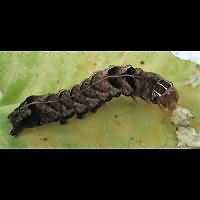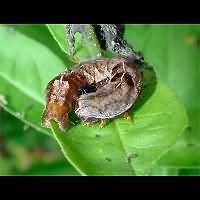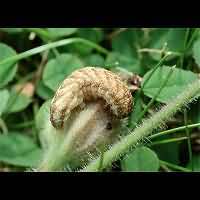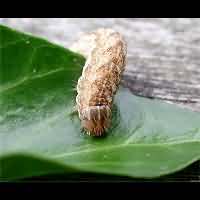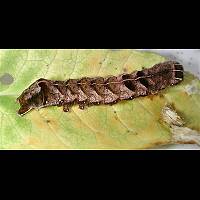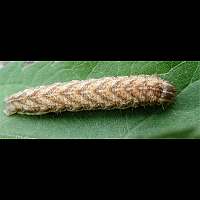Dot Moth Melanchra persicariae
We have no pictures of adult Dot Moths. We do have pictures of the caterpillar, though. It sometimes behaves very conspicuously by sitting or resting on top of leaves during daylight. You can hardly make a mistake identifying the Dot Moth. It is a dark moth with a very striking white dot. In the center of the dot often is a half moon shaped marking in grey or light brown. The basic colouring is a shiny kind of blackish or blueish dark brown. On the thorax is a bundle of reddish hairs. In rare cases the dot is almost invisible. In such a case the Dot Moth is similar to the Cabbage Moth. This however usually has a distinct white line with a W-shape in it. Reaching a wingspan of 38 to 50mm this is a rather typical Owlet Moth
The eggs are laid in summer, sometimes separately, sometimes in large groups and hatch after just one week. The caterpillars of the Dot Moth feed themselves especially at night. By day they usually rest on the underside of a leaf. Most of the caterpillars crawl into the ground in autumn, where they spin a cocoon in which they overwinter. Pupation takes place in spring in the same cocoon. A smaller part of the larvae overwinter in the host plant or among leaf litter. After overwintering these also go underground to pupate. The caterpillar comes in two colour varieties: brown or green. On the back there are a number of V-shaped markings, which especially stand out on the segments 4, 5 and 11. There also is a thin, white dorsal line. On the eleventh segment there is a conspicuous bump. The caterpillar will reach a length of some 40mm. The Dot Moth's caterpillar uses an enormous variety of foodplants. Lowgrowing plants such as dandelions are eaten, but also higher growing nettles and thistles, or shrubs and trees, such as birch and sallow. It is also interested in many garden plants, such as toadflax, fuchsia and dahlia
Even though the Dot Moth can be seen from June to September, the greatest numbers are on the wing in July. It flies by night only, but both males and females are easily attracted to light, sugar and flowers. Widespread and common in the south of England and Wales, becoming a more local species going northwards. Scarce in Ireland and absent in Scotland, except for the far south, where it is a rare and local species.
We have no pictures of adult Dot Moths. We do have pictures of the caterpillar, though. It sometimes behaves very conspicuously by sitting or resting on top of leaves during daylight. You can hardly make a mistake identifying the Dot Moth. It is a dark moth with a very striking white dot. In the center of the dot often is a half moon shaped marking in grey or light brown. The basic colouring is a shiny kind of blackish or blueish dark brown. On the thorax is a bundle of reddish hairs. In rare cases the dot is almost invisible. In such a case the Dot Moth is similar to the Cabbage Moth. This however usually has a distinct white line with a W-shape in it. Reaching a wingspan of 38 to 50mm this is a rather typical Owlet Moth
The eggs are laid in summer, sometimes separately, sometimes in large groups and hatch after just one week. The caterpillars of the Dot Moth feed themselves especially at night. By day they usually rest on the underside of a leaf. Most of the caterpillars crawl into the ground in autumn, where they spin a cocoon in which they overwinter. Pupation takes place in spring in the same cocoon. A smaller part of the larvae overwinter in the host plant or among leaf litter. After overwintering these also go underground to pupate. The caterpillar comes in two colour varieties: brown or green. On the back there are a number of V-shaped markings, which especially stand out on the segments 4, 5 and 11. There also is a thin, white dorsal line. On the eleventh segment there is a conspicuous bump. The caterpillar will reach a length of some 40mm. The Dot Moth's caterpillar uses an enormous variety of foodplants. Lowgrowing plants such as dandelions are eaten, but also higher growing nettles and thistles, or shrubs and trees, such as birch and sallow. It is also interested in many garden plants, such as toadflax, fuchsia and dahlia
Even though the Dot Moth can be seen from June to September, the greatest numbers are on the wing in July. It flies by night only, but both males and females are easily attracted to light, sugar and flowers. Widespread and common in the south of England and Wales, becoming a more local species going northwards. Scarce in Ireland and absent in Scotland, except for the far south, where it is a rare and local species.

